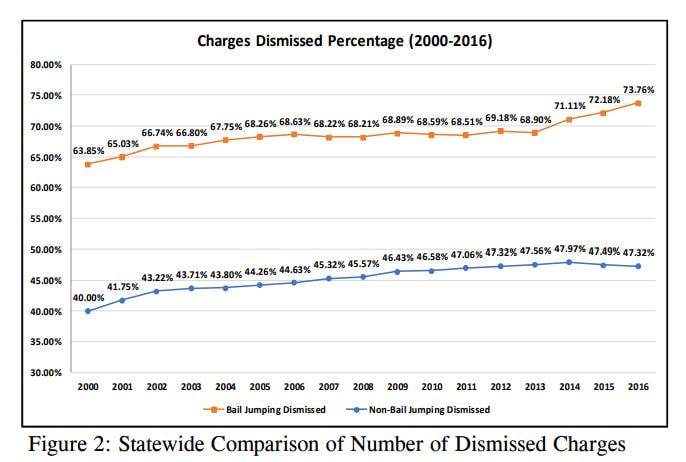The Plague of Bail Jumping Charges
134% increase in such charges in state since 2000 may force innocent people to plead guilty.
The number of criminal bail jumping charges resolved in the state jumped 134 percent from 2000 to 2016 and the number of those charges dismissed soared 170 percent, according to a new Wisconsin Law Review paper.
In 2000, bail jumping accounted for 7 percent of criminal charges adjudicated in the state; in 2016, that figure was 17 percent.
The data suggest that bail jumping charges are used to induce defendants “to plead to their original charge rather than to punish them for violating their bond conditions,” Amy Johnson wrote in “The Use of Wisconsin’s Bail Jumping Statute: A Legal and Quantitative Analysis.”
Johnson’s conclusion, buttressed by her quantitative findings, is something that defense lawyers also have argued based on their courtroom experiences.
There were 11,567 bail jumping misdemeanor and felony charges adjudicated in 2000 and 27,042 in 2016, an increase of 15,475. Of those resolved charges, 7,385, or 64%, were dismissed in 2000; by 2016, dismissals increased to 19,946, or 74% of bail jumping cases resolved.
The 74 percent figure “is particularly informative considering that for all other fully adjudicated charges in 2016 the percentage dismissed was a significantly lower 47.32% (61,852 of 130,713 charges),” Johnson wrote.
Johnson’s paper, published as a comment, called for state courts to embrace reforms that “prevents extreme numbers of bail jumping charges. Doing so would reduce the leverage effect that prosecutors have without eliminating it entirely.”
The courts’ past and current interpretations of the bail jumping statute has “led to an increase in bail jumping charges, absurd consequences, and potential sentences to the charged crimes,” she wrote. “The result is that defendants are at a marked disadvantage when negotiating plea deals.”
The Wisconsin Supreme Court, for example, has held that a defendant can be charged with multiple counts of bail jumping for violating a single bond. Johnson, as an example cited the example of a J.E., a composite of clients in actual cases she worked on during a 2016 legal internship.
J.E., she said, is an alcoholic homeless man who got into a disturbance with another man on Madison’s State Street. Both men were charged with disorderly conduct; both admitted to being under the influence of alcohol. J.E. was granted a signature bond, but as conditions of that bond, was ordered to maintain absolute sobriety and to stay away from State Street.
A few weeks later police arrested an intoxicated J.E. on State Street. He was charged with two counts of misdemeanor bail jumping.
“Ultimately, J.E. agreed to a plea deal that would dismiss the bail jumping charges if he pled guilty to the disorderly conduct….,” Johnson wrote. “Even if he was acquitted of the disorderly conduct, he would still have been subject to the bail jumping charges, and the likelihood of conviction resulting from those charges was too great for him not to take the plea.”
Johnson graduated this spring from the University of Wisconsin Law School. Before she enrolled, she was an IT project manager and analyst for more than 20 years. During that time, she managed large software projects and gained considerable experience analyzing data.
She said she got interested in the bail jumping topic when she read a State Supreme Court bail jumping decision, State v. Anderson. The court held that it was fine and dandy to issue multiple criminal charges for multiple violations of a single bond. In her paper, Johnson said that then-Justice Janine Geske, in a dissent, “points out a variety of scenarios where a detailed set of bond conditions that are violated could result in punishments that far exceed the initial crime.”
She continued: “This seems particularly outrageous when many conceivable conditions, like not drinking or not being in a certain area of town, are not criminal acts in and of themselves. A defendant with one criminal felony count could end up with punishment for violating bail conditions that far exceed the punishment for the crime itself.”
Geske’s dissent, Johnson said in an email, “rang very true based my anecdotal observations while working with clients that had bail jumping charges. I was curious about whether she was right or not.”
Johnson’s planned paper “turned into a research project that took hundreds of hours,” she said.
Johnson analyzed Wisconsin Consolidated Court Automation Programs (CCAP) data for the years 2000 through 2016. The data included more than 1.6 million cases and 3.2 million charges.
Statewide, disorderly conduct was the most frequently resolved offense in 2000, while misdemeanor bail jumping – charged when the underlying crime is a misdemeanor – was the fifth most common charge. Felony bail jumping was the tenth most commonly adjudicated crime.
“Combined, bail jumping was third overall but the number of bail jumping charges was less than half of the number of disorderly conduct charges,” she wrote.
That changed dramatically by 2016.
“Disorderly conduct was first,” she wrote. “Misdemeanor and felony bail jumping were second and third, respectively. However, combined, bail jumping was the number one charge in Wisconsin, ahead of disorderly conduct by over 5,000 charges.”
The number of cases with multiple bail jumping counts loaded on to them also have increased, Johnson wrote.
In 2000, 23 percent of bail jumping cases closed had more than bail jumping charge; in 2016, the percentage was 35 percent.
“Were Justice Geske’s assertions in her dissent in Anderson correct?” Johnson wrote. “Has the bail jumping statute and its interpretations resulted in a large number of bail jumping charges and an excessive exposure to penalties? The CCAP data suggests that she was indeed correct.”
Gretchen Schuldt writes a blog for Wisconsin Justice Initiative, whose mission is “To improve the quality of justice in Wisconsin by educating the public about legal issues and encouraging civic engagement in and debate about the judicial system and its operation.
Court Watch
-
No Unemployment Benefits For Worker Making Homophobic Remarks
 May 17th, 2022 by Gretchen Schuldt
May 17th, 2022 by Gretchen Schuldt
-
Appeals Court Upholds Injunction Against Abortion Protester
 Mar 13th, 2022 by Gretchen Schuldt
Mar 13th, 2022 by Gretchen Schuldt
-
80% of State’s Judicial Races Uncontested
 Feb 20th, 2022 by Gretchen Schuldt
Feb 20th, 2022 by Gretchen Schuldt



























What exactly is “bail jumping?” I re-read the article and didn’t find it defined.
Bail jumping can simply mean that the perps don’t show up in court for trials, or keep the Courts/Law enforcement informed of address changes, etc., or abide by other rules set down by the Courts that let them out on bail. Failure to appear as instructed by the Court for a trial date is the best example. You do not have to flee the Country to commit this offense.
That being said, our Criminal Justice system is spineless in this regard, and does little to SERIOUSLY enforce compliance. Being out on bail has always meant you must follow certain, more stringent rules than the average citizen. Many do not. When people don’t show up, time and money is spent to track the individual down, and/or issue warrants. Let alone, the victim is left without receiving justice in his/her case for months or years when they show up, but the bad guy doesn’t. We can’t even get GOOD people to notify the DOT of things like a change of address…let alone, get perpetrators who are out on bail to let the courts know where they migrate to. AT THE VERY LEAST, THE DEFENDANT WHO DOES NOT FOLLOW THE RULES SET DOWN BY THE COURTS SHOULD COVER ALL COSTS, including the costs to the Courts, paid overtime for Police Officers, etc.. Not to mention, it clogs the Court calendars for ALL cases because it means they will require case continuances or added staff (and overcrowds the system).
Fines, or restitution, and being out on bail has traditionally been a way to enforce compliance or reduce jail and incarceration costs. And according to this article, two out of every three criminals that don’t show up are dismissed anyways. Can we think of it as aother revolving door? Judge’s feel sorry for the criminal in too many cases. Today’s Criminal Justice system wants to be a kindler, gentler, feel good system that overburders the victim and taxpayer by not enforcing compliance by criminals. So of course “trials” or “hearings” for those that abide by the rules are often times a year or more away because of overcrowded court calendars.
It’s violating the conditions of bail. For instance, if, as a condition of your bail, you are ordered not to drink and you have a beer, you are in violation of the terms of your bail and thus are bail jumping.
Could be anything from a new criminal arrest while out on bail to violation of a condition of bail such as a no drink, no contact, or no drug use condition a judge may put on as a condition of release on bail. The criminal system should decide if it is going to try to control people’s behaviors or hold people responsible for criminal acts. Both are huge challenges, but the former is just plain farce.
I agree; I don’t understand it either.
I guess I was hoping that someone from Urban Milwaukee might notice that this article could benefit from some editing. In its present form, it reads like it belongs in a law journal, and not on a general news type website.
Thanks, all, actually realized in the middle of the night I hadn’t defined it. Sorry – my error. So, here goes (and I’m hoping this will be added as an update to the story):
Felony bail jumping occurs when a person out on bond on a felony charge violates the conditions of that bond. Misdemeanor bail jumping occurs when a person out on bond on a misdemeanor charge violates the conditions of that bond.
A bail jumping offense may not by itself be a crime. Missing a court date, violating a local ordinance, or having a drink could all be bail jumping offenses if bond conditions prohibit those things.
Misdemeanor bail jumping carries a maximum penalty of nine months in jail and a $10,000 fine; felony bail jumping carries a maximum penalty of six years in prison and a 10,000 fine.
The charges and penalties mean that a person charged with, for example, a felony that carries a two-year maximum sentence could face an additional six years in prison if they violate their bond in any way.